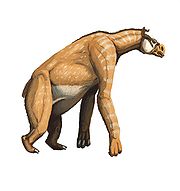
Chalicotherioidea
Encyclopedia
Chalicotherioidea is an extinct group of clawed perissodactyls that lived from the early Eocene
to the Pleistocene
subepochs. It began and thrived largely in Eurasia
, based on the fossil record, although specimens have been found in both Africa
and North America
. They were likely browsers
that fed mainly on leaves, twigs, and other nonresistant vegetation. Many of the contained genera
had derived specializations of the forelimb
and manus
that allowed the claws to be used as hooks for browsing and to be kept off of the ground while walking. Chalicotheres lived primarily in forested areas. Size sexual dimorphism
and morphological structures such as the domed skulls of Tylocephalonyx
suggest agonistic behaviour
in some sort of social setting. They are related to the extinct brontotheres, as well as modern day horse
s, rhinoceros
es, and tapir
s.

Eocene
The Eocene Epoch, lasting from about 56 to 34 million years ago , is a major division of the geologic timescale and the second epoch of the Paleogene Period in the Cenozoic Era. The Eocene spans the time from the end of the Palaeocene Epoch to the beginning of the Oligocene Epoch. The start of the...
to the Pleistocene
Pleistocene
The Pleistocene is the epoch from 2,588,000 to 11,700 years BP that spans the world's recent period of repeated glaciations. The name pleistocene is derived from the Greek and ....
subepochs. It began and thrived largely in Eurasia
Eurasia
Eurasia is a continent or supercontinent comprising the traditional continents of Europe and Asia ; covering about 52,990,000 km2 or about 10.6% of the Earth's surface located primarily in the eastern and northern hemispheres...
, based on the fossil record, although specimens have been found in both Africa
Africa
Africa is the world's second largest and second most populous continent, after Asia. At about 30.2 million km² including adjacent islands, it covers 6% of the Earth's total surface area and 20.4% of the total land area...
and North America
North America
North America is a continent wholly within the Northern Hemisphere and almost wholly within the Western Hemisphere. It is also considered a northern subcontinent of the Americas...
. They were likely browsers
Browsing (predation)
Browsing is a type of herbivory in which an herbivore feeds on leaves, soft shoots, or fruits of high growing, generally woody, plants such as shrubs. This is contrasted with grazing, usually associated with animals feeding on grass or other low vegetation...
that fed mainly on leaves, twigs, and other nonresistant vegetation. Many of the contained genera
Genera
Genera is a commercial operating system and development environment for Lisp machines developed by Symbolics. It is essentially a fork of an earlier operating system originating on the MIT AI Lab's Lisp machines which Symbolics had used in common with LMI and Texas Instruments...
had derived specializations of the forelimb
Forelimb
A forelimb is an anterior limb on an animal's body. When referring to quadrupeds , the term foreleg is often instead used....
and manus
Manus (zoology)
The manus is the zoological term for the distal portion of the fore limb of an animal. In tetrapods, it is the part of the pentadactyl limb that includes the metacarpals and digits . During evolution, it has taken many forms and served a variety of functions...
that allowed the claws to be used as hooks for browsing and to be kept off of the ground while walking. Chalicotheres lived primarily in forested areas. Size sexual dimorphism
Sexual dimorphism
Sexual dimorphism is a phenotypic difference between males and females of the same species. Examples of such differences include differences in morphology, ornamentation, and behavior.-Examples:-Ornamentation / coloration:...
and morphological structures such as the domed skulls of Tylocephalonyx
Tylocephalonyx
Tylocephalonyx is an extinct dome-headed chalicothere from the Miocene in North America.It may have used its "dome" in the same way as the pachycephalosaurs...
suggest agonistic behaviour
Agonistic behaviour
In ethology, agonistic behaviour is any social behaviour related to fighting. Thus it is broader than aggressive behaviour because it includes not only actual aggression but also threats, displays, retreats, placating aggressors, and conciliation. The term was coined by Scott and Fredericson in 1951...
in some sort of social setting. They are related to the extinct brontotheres, as well as modern day horse
Horse
The horse is one of two extant subspecies of Equus ferus, or the wild horse. It is a single-hooved mammal belonging to the taxonomic family Equidae. The horse has evolved over the past 45 to 55 million years from a small multi-toed creature into the large, single-toed animal of today...
s, rhinoceros
Rhinoceros
Rhinoceros , also known as rhino, is a group of five extant species of odd-toed ungulates in the family Rhinocerotidae. Two of these species are native to Africa and three to southern Asia....
es, and tapir
Tapir
A Tapir is a large browsing mammal, similar in shape to a pig, with a short, prehensile snout. Tapirs inhabit jungle and forest regions of South America, Central America, and Southeast Asia. There are four species of Tapirs: the Brazilian Tapir, the Malayan Tapir, Baird's Tapir and the Mountain...
s.


